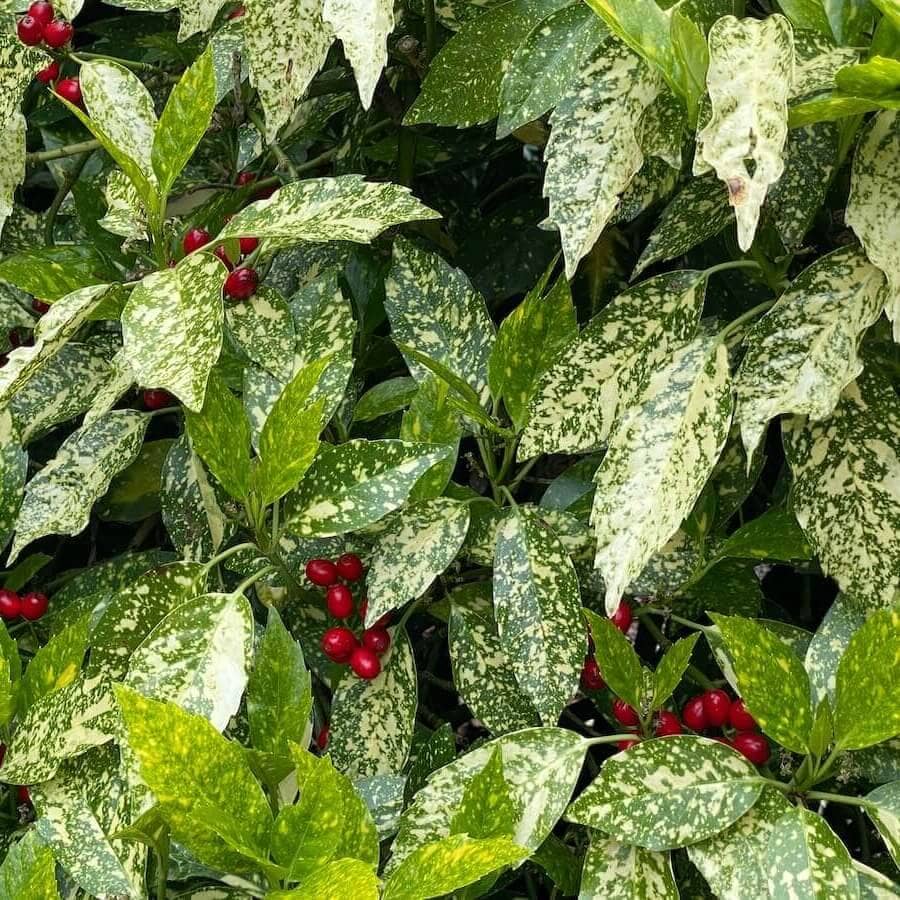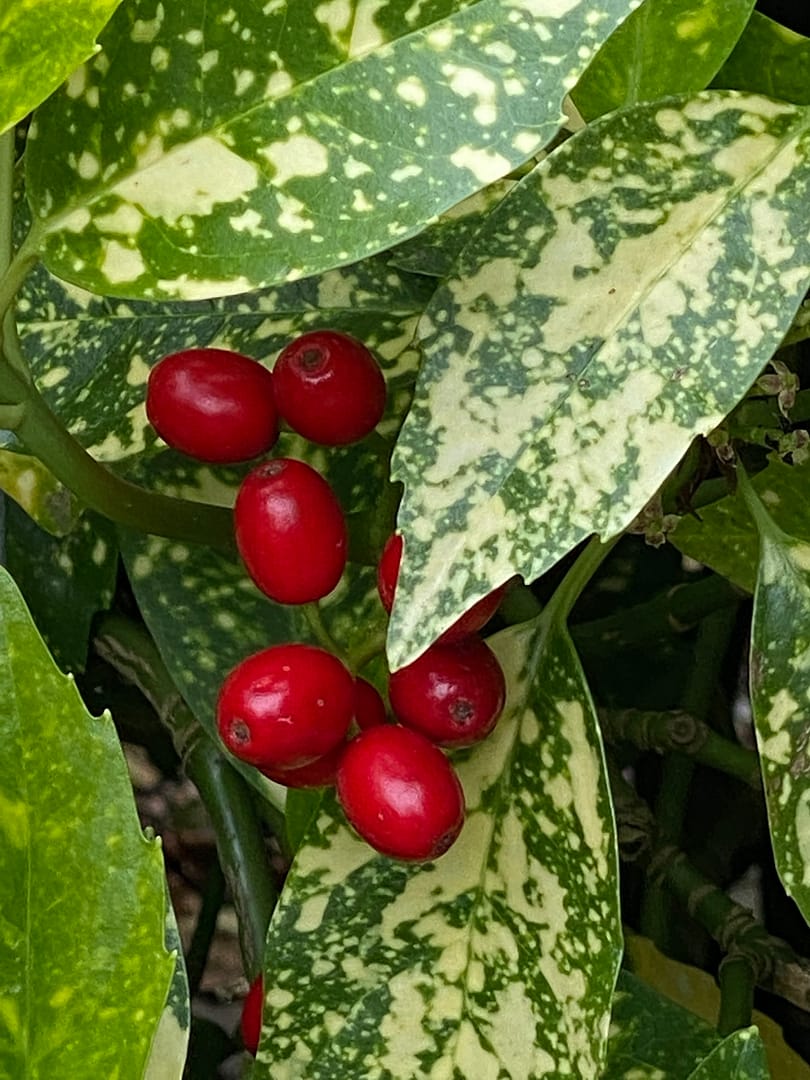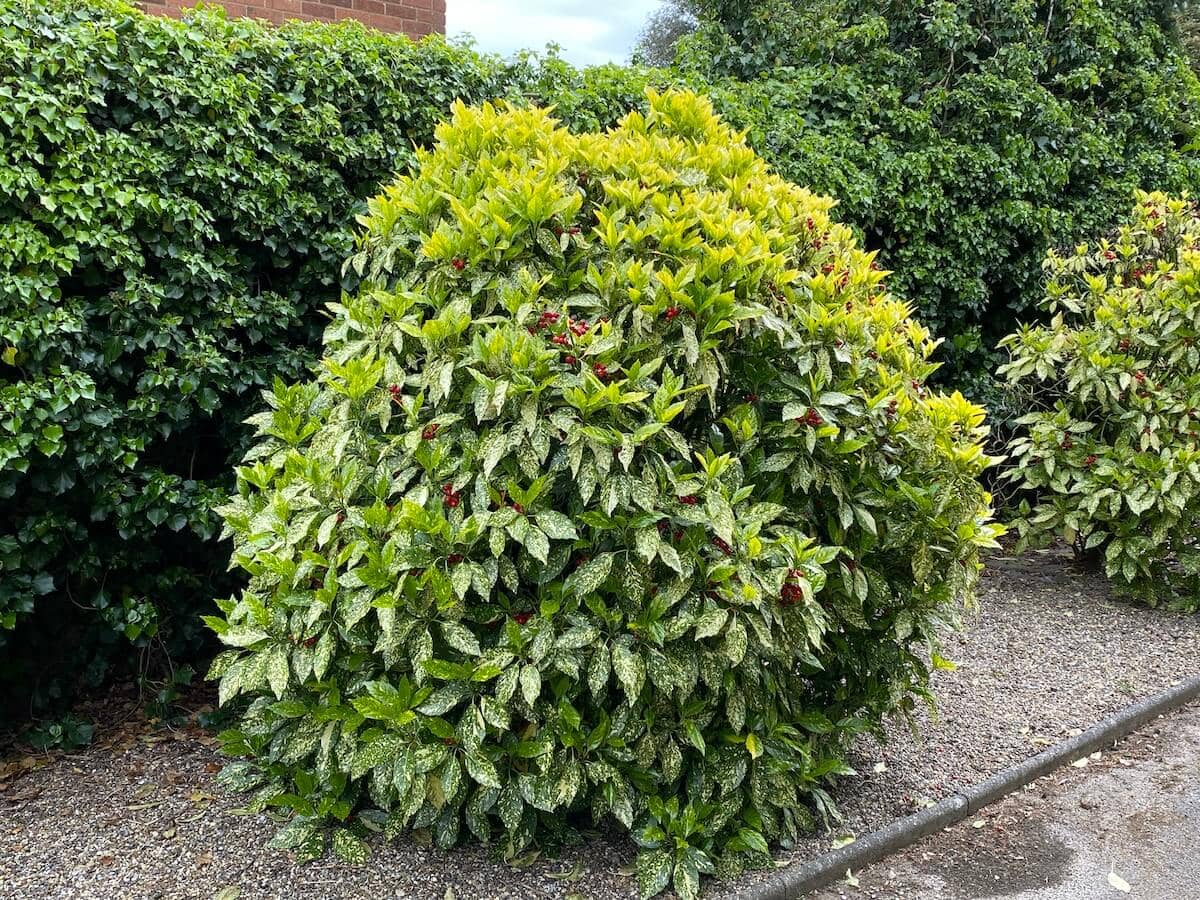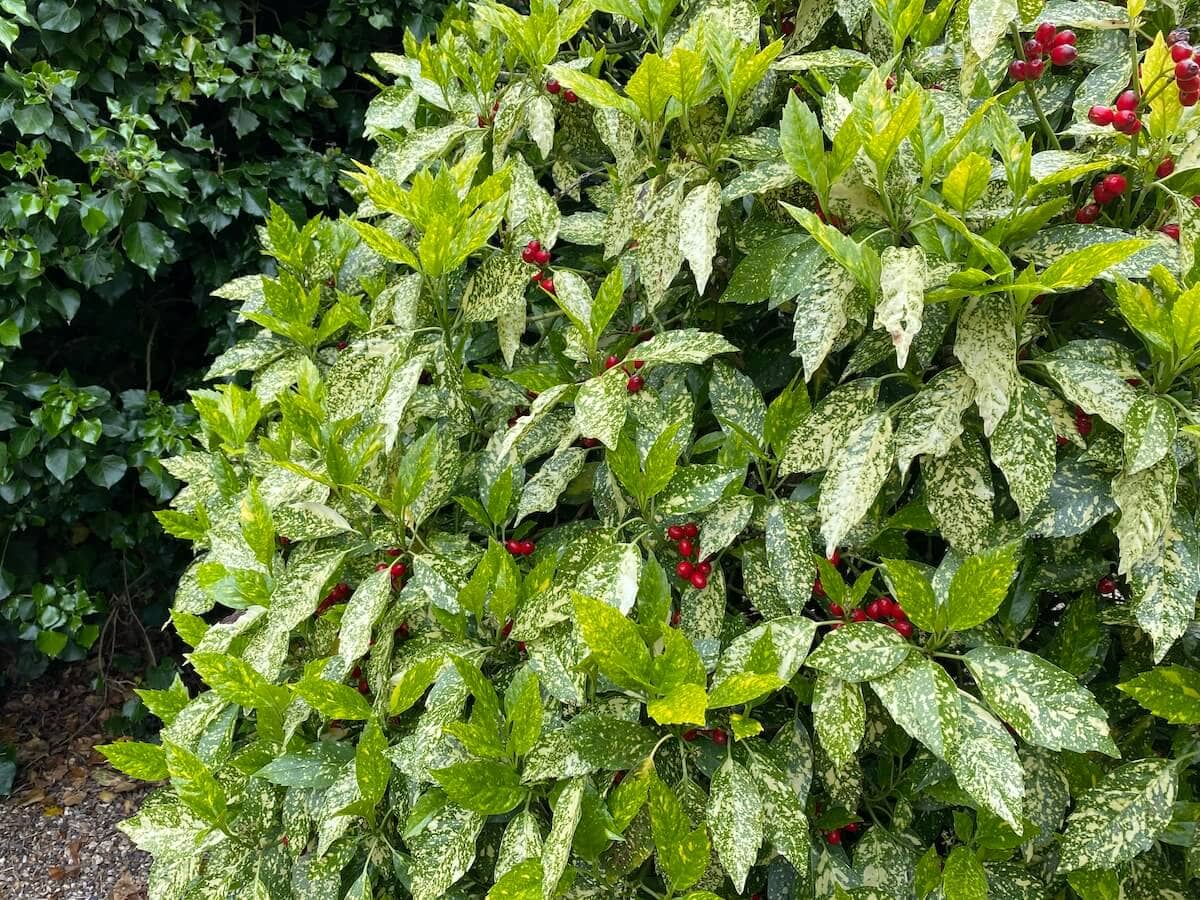
Position
- Sun Requirement: Prefers partial shade to full shade.
- Location: Best placed away from harsh sunlight to preserve leaf variegation.
Hardiness
- Tolerates temperatures down to approximately -15°C (5°F)
Soil Type
- Prefers a well-drained, moist soil, often thriving in loamy or sandy soils.
Soil PH
- Tolerates a range from slightly acidic to neutral (pH 6.0-7.0)
- It can generally adapt to neutral to slightly alkaline conditions as well
- Grab a soil test kit and ensure the perfect conditions for growth
Height
- Typically reaches a height of 1.5 to 2.5 metres (5 to 8 feet) after 5 to 10 years.
Seasons of Interest
- Foliage Interest:
- Variegated leaves provide interest year-round.
- Retains colour throughout autumn and winter.
- Flowering Times:
- Produces inconspicuous yellow flowers from late winter to early spring (February to April).
- Flowers are not particularly showy but are attractive to pollinators.
- Berries:
- Female plants produce small, bright red berries in autumn, adding further interest to the garden and attracting birds.
Additional Notes
- Planting: Plant where the striking foliage can be appreciated.
- Pruning: Prune in spring to remove dead or damaged growth and maintain shape. Minimal pruning is generally required.
- Dioecious: Aucuba japonica is dioecious, meaning male and female flowers are on separate plants. Only female plants produce berries; they need a male plant nearby for pollination.
- Propagation: Easily propagated by semi-hardwood cuttings in late summer.
Meet the Spotted Laurel: A Year-Round Star for Shady Gardens
Aucuba japonica Variegata, commonly known as the Gold Dust Plant or Spotted Laurel, is an eye-catching evergreen shrub that brings bold colour and structure to the garden all year round. Its unique foliage—broad, glossy green leaves generously speckled with bright yellow—offers a luminous, almost tropical feel, even in the most shaded corners. Whether planted as a standalone specimen, grouped for impact, or used as part of a mixed border, this striking shrub creates a vivid focal point that instantly lifts the surrounding space.
What sets Aucuba japonica Variegata apart is its ability to flourish where many other plants falter. It’s particularly well-suited to dry shade, making it an ideal choice for tricky spots beneath trees, along north-facing walls, or in areas with minimal sunlight. Hardy, low-maintenance, and highly adaptable, this shrub brings not only ornamental value but also practical resilience to the garden. Its year-round foliage ensures continuous interest, while its toughness makes it a reliable performer in a wide range of settings, from city courtyards to woodland gardens.
Ideal Growing Conditions
Aucuba japonica Variegata is well-suited for shaded areas, making it ideal for north-facing gardens or spots beneath larger trees. It performs best in temperatures ranging from -10°C to 35°C (14°F to 95°F), demonstrating impressive resilience across a variety of climates. The shrub can grow up to 2.5 metres (8 feet) in height and width, creating an attractive, dense bush.
Plant your Aucuba in well-draining soil enriched with organic matter for best results. While it tolerates a range of soil types, it prefers slightly acidic to neutral soils. It’s a good idea to test your soil’s pH before planting to ensure it falls within the ideal range—this helps the plant absorb nutrients more efficiently and establishes a strong, healthy root system. Regular watering is essential to keep the soil moist but not waterlogged. In dry spells, increase watering frequency to prevent leaf scorch.

Seasonal Care Tips
Learning to care for Aucuba japonica Variegata throughout the year will ensure it remains healthy and vibrant.
In spring, apply a balanced, slow-release plant food to promote vigorous growth. Prune any branches damaged by winter storms and refresh the mulch layer to retain moisture.
During summer, keep the plant hydrated, especially during hot spells. Monitor for leaf scorch and protect from intense sunlight if necessary. Regularly check for any pest issues.
In autumn, reduce watering as temperatures drop. Clear debris or fallen leaves from around the plant base to prevent fungal diseases. If female plants are present, watch for the development of bright red berries, which add winter interest.
Use a screen to protect the plant from harsh winter weather. Remove heavy snow loads from branches promptly to prevent breakage. Hold off on pruning until early spring to avoid frost damage.
Planting Your Aucuba
Choose a location that offers partial to full shade and is sheltered from harsh winds. Begin by digging a hole twice as wide as the root ball and of the same depth to encourage healthy root spread. Enhance the soil with well-rotted manure to support growth. Place the plant carefully into the hole and backfill with soil. Firm it gently to remove air pockets. Water thoroughly after planting and apply a 5cm (2-inch) layer of mulch to conserve soil moisture and suppress weeds. If creating a hedge, space each plant 1 to 1.5 metres (3-5 feet) apart to allow room for growth.
Pruning and Maintenance
Pruning your Aucuba japonica Variegata helps maintain its shape and health. The best time to prune is early spring, before the new growth begins. Trim back dead or crossing branches to improve air circulation and overall plant health. This plant is resilient and can handle hard pruning to rejuvenate older shrubs.
Common Issues and Solutions
While Aucuba japonica Variegata is hardy, it can experience a few common problems. Yellowing leaves often indicate too much sun exposure or improper watering. If the leaf edges turn brown, it might be due to cold winds or insufficient moisture. Please check your watering schedule and use protective measures to protect the plant from harsh conditions.
Pests like scale insects or vine weevils can occasionally cause trouble. To control these pests, regularly inspect your plant and apply insecticidal soap or neem oil if necessary. For vine weevil larvae in the soil, consider using biological control methods such as nematodes (Steinernema kraussei or Heterorhabditis species), which are highly effective when applied to moist soil during spring or autumn.


Landscape Design Ideas
Aucuba japonica Variegata is a versatile plant with many uses in garden design. It works well in shaded borders, large containers, and woodland settings. Its bold foliage pairs beautifully with hostas, ferns, hellebores, and Japanese forest grass, creating dynamic textures and colour contrasts. For added visual appeal, you can plant it where the winter berries can be viewed, providing seasonal interest.
Why Choose Aucuba japonica Variegata?
This plant is a fantastic choice due to its easy-care nature and adaptability. It offers year-round colour, can tolerate urban pollution, is resistant to drought once established, and serves as effective screening or hedging through its dense growth. This makes it an excellent option for novice and experienced gardeners looking for reliable and attractive garden plants.
Purchasing Tips
When buying Aucuba japonica Variegata, look for plants with deep green, glossy leaves sporting bright yellow spots. Check for healthy root development and no signs of disease or pest damage. A good nursery plant will typically have multiple stems to ensure robust growth.
Planting and caring for Aucuba japonica Variegata rewards you with a stunning and resilient garden feature. With consistent care and attention to its needs, this shrub will bring beauty and structure to your outdoor space all year round. Whether for a formal garden setup or a relaxed natural look, this plant provides a reliable solution with unique and lively foliage.
Continue your garden journey with Pittosporum tenuifolium Tom Thumb. Click here to learn more.
For more information on Shrubs, please click here.
From Darren’s Patch
I’ve always had a soft spot for Aucuba japonica Variegata—it’s one of those dependable plants that never lets you down. I grew up with one in my parents’ garden, nestled under the deep shade of a towering monkey puzzle tree. Even in that dry, gloomy corner, it thrived—those golden-speckled leaves catching the light and adding a splash of colour year-round. Now in my garden, I’ve planted it beneath an old cherry tree, which continues to impress with its resilience and vibrant foliage. I love pairing it with ferns and hellebores for that layered, woodland look. If you’re tackling a tricky shady spot, I can’t recommend this shrub enough—tough, tidy, and endlessly rewarding.
![]()
Frequently Asked Questions
Q: How tall does Aucuba japonica Variegata grow?
A: Aucuba japonica Variegata typically reaches 1.5-2.5 metres (5-8 feet) over time. It has a bushy, upright form that makes it an excellent choice for both hedges and specimen plants.
Q: What type of soil does it prefer?
A: This plant thrives in well-drained soil, whether clay, loam, or sandy. It prefers rich, organic matter, but can tolerate poor soil conditions as long as water drainage is good.
Q: How much shade does Aucuba japonica Variegata require?
A: It performs best in partial to full shade. Although it can withstand some sun, direct sunlight may scorch the variegated leaves, resulting in a less vibrant colour.
Q: When does Aucuba japonica Variegata flower?
A: Aucuba japonica Variegata produces small, yellow flowers in spring. However, the plant is mainly prized for its attractive foliage rather than its flowers.
Q: What is the hardiness of Aucuba japonica Variegata?
A: This plant is hardy down to -15°C (5°F). It adapts well to the UK climate but is best placed in a sheltered location to protect from cold winds.
Q: Is Aucuba japonica Variegata suitable for containers?
A: Yes, it is well-suited for container growing. Use a large pot with good drainage and fill it with high-quality compost. Ensure to water regularly, especially during dry spells.
Q: How often should I water it?
A: Water moderately, allowing the top inch of soil to dry out between waterings. In summer, increase watering frequency during hot, dry periods to maintain moisture.
Q: Does it need regular pruning?
A: Light pruning is beneficial for maintaining a tidy shape. Prune in spring after flowering to remove dead or damaged branches. Avoid heavy pruning, as it can affect growth.
Q: What wildlife does it attract?
A: Aucuba japonica Variegata can attract various birds due to its berries. It provides excellent shelter, making it a great addition to wildlife-friendly gardens.
Q: Are there any common pests or diseases?
A: This plant is generally pest-resistant but may occasionally attract scale insects or aphids. Regular checks and good air circulation can help prevent problems. Fungal issues may occur in overly wet conditions, so ensure well-drained soil.
